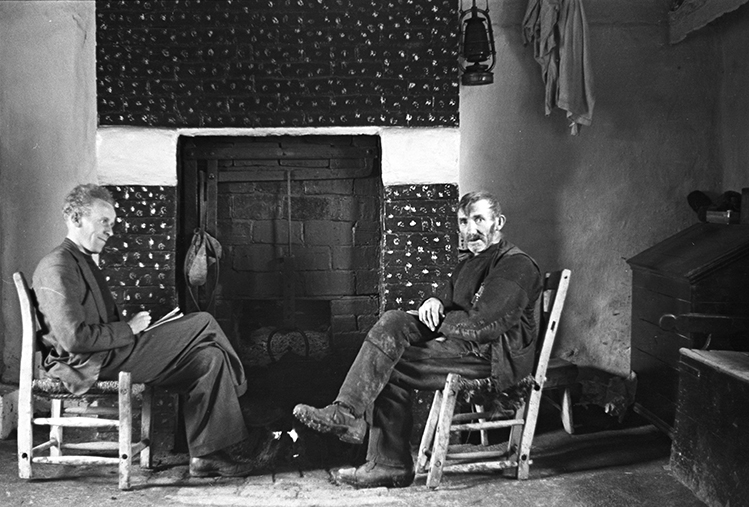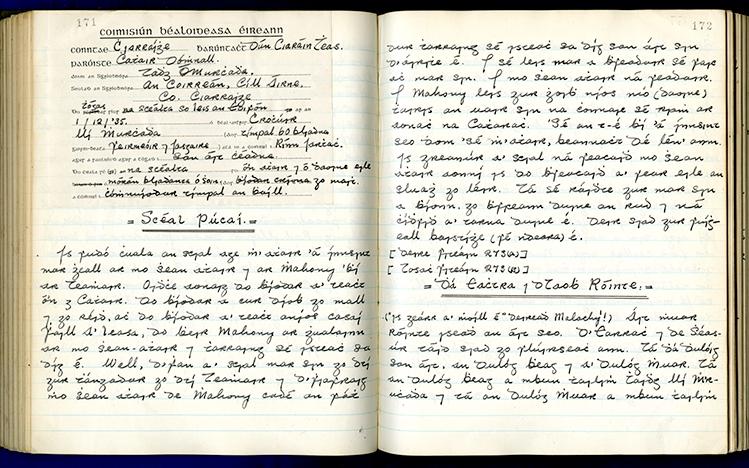National Folklore Collection at UCD inscribed into UNESCO Memory of the World Register

Posted December 06, 2017
In recognition of its “world significance” and “outstanding universal value to culture”, the (opens in a new window)Irish Folklore Commission Collection 1935-1970 at University College Dublin has been inscribed into the (opens in a new window)UNESCO Memory of the World Register.
The Register has a total of 427 collections and documents from around the world on materials from stone to celluloid and from parchment to sound recordings.
It includes the Magna Carta, the Diary of Anne Frank, the Bayeux Tapestry and the Book of Kells (the only other Irish entry - registered in 2011).
President Higgins has welcomed the inclusion of The Irish Folklore Commission in the (opens in a new window)@UNESCO ‘Memory of the World’ register:(opens in a new window)https://t.co/HOKqraUPTK
— President of Ireland (@PresidentIRL) (opens in a new window)December 6, 2017
Joe McHugh TD Government Chief Whip and Minister of State with responsibility for Gaeilge, Gaeltacht and the Islands said:
"This award provides due recognition of the importance of the collection, not just here in Ireland, but internationally as well. The archive which was assembled assiduously by the Irish Folklore Commission is one of the largest of its kind, comprising several thousand manuscript volumes of transcriptions, some 90,000 photographs and more than 10,000 hours of audio recordings."
"All of this work was carried out during a period in our history when profound language, social and cultural change was taking place. The collection therefore forms a unique record of Irish cultural life, society, the verbal arts and music. Many significant elements of the collection have been digitized and published on the Dúchas.ie website in recent years, and I look forward to the continuation of this work."
Irish folklore archive inscribed into UNESCO's Memory of the World Register (opens in a new window)pic.twitter.com/ybRSAF8BBP
— RTÉ News (@rtenews) (opens in a new window)December 6, 2017
By 1928, the lifestyle of the Irish people was undergoing rapid and fundamental changes. “Old rural customs, such as gathering for a night of storytelling by the fireside in hospitable homes, was being abandoned. A whole culture was in danger of being discarded, unrecorded and lost forever,” noted TK Whitaker.
The Irish Folklore Commission was established in 1935 to collect and preserve Ireland’s declining oral tradition and vulnerable cultural heritage. In 1971, the Irish Folklore Commission, its staff and holdings were transferred to University College Dublin for continued development and safeguarding.
Today, The Irish Folklore Commission Collection at University College Dublin is among the richest, most diverse tradition archives in existence anywhere in the world.
Over decades, it made thousands of tape-recordings of speech in the Irish language, but also of song and music. Photographs, sketches and other pictorial representations were also collected.
It contains almost 4,000 manuscripts of interview [transcripts] as well as native hero tales and sagas, wonder tales, local legends, poetry, historical tradition and place-name lore, in both Irish and English. These interviews contain invaluable descriptions of Irish material culture, including vernacular architecture, and traditional Irish society.
Audio and film footage from the 1940s of renowned storytellers like Peig Sayers, and performances of Irish folk drama such as “Wren Boys” and “Mummers” also form part of the collection.
There are several thousand acetate disk records of native Gaelic speakers dating from the 1940s/50s alongside a substantial collection of high quality magnetic tape recordings dating from the 1950s through to the 1960s.
Twenty-one full time, [and a great many part-time and voluntary, collectors] were employed by the Commission at various times throughout its existence, many of whom were in the Gaeltacht areas of rural Ireland.
Some 90,000 archive photographs (film negatives and transparencies) were taken by Commission fieldworkers, and a substantial collection of paintings and drawings
UNESCO established the Memory of the World Programme in 1992 in response to a growing awareness of the precarious state of preservation of, and access to, documentary heritage in various parts of the world. War and social upheaval, as well as severe lack of resources, have worsened problems which have existed for centuries. Significant collections worldwide have suffered a variety of fates. Looting and dispersal, illegal trading, destruction, inadequate housing and funding have all played a part. Much has vanished forever; much is endangered.
The UNESCO Memory of the World Register - in some ways the most publicly visible aspect of the Memory of the World Programme - was founded on the 1995 General Guidelines and has grown through accessions approved by successive International Advisory Committee meetings.
Irish Folklore Commission Collection 1935-1970 at University College Dublin is accessible to the public by guided tours, information sessions and digitally at www.ucd.ie/folklore and (opens in a new window)www.duchas.ie
By: Dominic Martella, UCD University Relations
Cnuasach Bhéaloideas Éireann i UCD le háireamh ar Chlár Chuimhne an Domhain UNESCO
Mar aitheantas ar an "tábhacht dhomhanda" agus "an luach domhanda thar na bearta don chultúr" tá Cnuasach Choimisiún Bhéaloideas Éireann sa Choláiste Ollscoile, Baile Átha Cliath le háireamh ar Chlár Chuimhne an Domhain UNESCO.
Tá 427 cnuasach ar fad ar an gClár chomh maith le cáipéisí ó ar fud an domhain idir ábhar faoi chlocha go ceallalóid agus ó mheamram go taifeadtaí fuaime.
Áirítear ann an Magna Carta, Dialann Anne Frank, Taipéis Bayeux agus Leabhar Cheanannais (an t-aon ábhar eile as Éirinn - a cláraíodh in 2011).
Bhí athrú mór agus tapa ag teacht ar an saol in Éirinn faoin mbliain 1928. Mar a dúirt TK Whitaker “bhí sean-nósanna, amhail cruinniú ar an teallach ag scéalaíocht, á dtréigean. Bhí cultúr ar leith i mbaol, gan cuntas, bheadh sé imithe go brách.”

Joe McHugh TD: "Dearbhaíonn an gradam tábhacht an chnuasaigh, ní amháin in Éirinn ach go hidirnáisiúnta. Tá an chartlann seo, a thiomsaigh Coimisiún Bhéaloideas Éireann le cúram agus le díograis, ar cheann de na cnuasaigh dá shórt is mó ar domhain. Áirítear os cionn 4,000 lámhscríbhinní, suas le 90,000 míle grianghraif agus os cionn 10,000 uaireanta chloig de thaifid fhuaime ann. Cuireadh an obair seo i gcrích fad is a bhí athruithe móra teanga, shóisialta agus cultúrtha ag tarlú in Éirinn, rud a chiallaíonn go bhfuil cuntas luachmhar, leithleach de shlí bheatha agus caithimh aimsire dúchasach na ndaoine caomhnaithe dúinn. Le blianta beaga anuas tá míreanna suntasacha den chnuasach digithe agus foilsithe ar an suíomh gréasáin (opens in a new window)www.duchas.ie, agus táim ag súil go leanfar leis an obair amach seo."
Bunaíodh Coimisiún Bhéaloideas Éireann i 1935 chun béaloideas agus oidhreacht chultúir na hÉireann, a bhí faoin tráth sin i mbaol agus ag dul i léig, a bhailiú agus a chaomhnú. I 1971 aistríodh Coimisiún Bhéaloideas Éireann, an fhoireann agus a chuid sealúchas go dtí an Coláiste Ollscoile, Baile Átha Cliath ar mhaithe lena fhorbairt tuilleadh agus a chosaint.
Tá Cnuasach Choimisiún Bhéaloideas Éireann sa Choláiste Ollscoile, Baile Átha Cliath ar cheann de na cartlanna traidisiún is saibhre agus is éagsúil in áit ar bith ar fud an domhain.
Tugadh faoi na mílte taifeadtaí fuaime de chaint i nGaeilge ar feadh na mblianta chomh maith le hamhráin agus ceol a thógáil. Bailíodh grianghraif, sceitsí agus léaráidí freisin.
Tá beagnach 4,000 lámhscríbhinn ann d'agallaimh [trascríbhinní] chomh maith le scéalta dúchasacha gaisce, cseanscéalta iontais, eachtraí áitiúla, filíocht, traidisiúin agus seanchas faoi logainmneacha, i nGaeilge agus i mBéarla. Déantar cur síos ríluachmhar sna hagallaimh seo ar chultúr ábhartha na hÉireann ar a n-áirítear ailtireacht na háite agus sochaí thraidisiúnta na hÉireann.
Mar chuid den chnuasach freisin tá píosaí scannánaíochta agus fuaime ó na 1940í de sheanchaithe mar Peig Sayers agus de dhrámaíocht phobail na hÉireann mar "lucht an Dreoilín" agus "Cleamairí".
Sa chnuasach freisin tá na mílte taifeadtaí ar dhioscaí aicéatáite de chainteoirí dúchais Gaeilge ó na 1940í/50í chomh maith le bailiúchán suntasach de thaifeadtaí ar théipeanna maighnéadacha ar ardchaighdeán ó na 1950í amach go dtí na 1960í.
Bhí bailitheoir is fiche [agus neart eile go páirtaimseartha agus go deonach] fostaithe ag an gCoimisiún ag amanna éagsúla, go leor díobh i gceantair Ghaeltachta faoin tír in Éirinn.
Tá suas le 90,000 grianghraf (claonchlónna agus tréshoilseáin) sa Chartlann a ghlac oibrithe allamuigh an Choimisiúin mar aon le cnuasach mór de phéintéireachtaí agus tarraingtí.
I 1992 bhunaigh UNESCO clár Cuimhne an Domhain mar fhreagra ar an tuiscint a bhí ann, agus a bhí ag méadú, go raibh ábhar oidhreachta in áiteanna éagsúla ar fud an domhain i mbaol ceal caomhnaithe agus rochtana. Ba mheasa ná sin an scéal mar ghealla ar chogadh, suaitheadh sóisialta chomh maith le heaspa acmhainní leis na céadta bliain. Ní hé an deireadh céanna a bhí ag bailiúcháin mhóra éagsúla ar fud an domhain. Goideadh ábhar, scaipeadh é, rinneadh trádáil mhídhleathach air nó scriosadh é. Bhí ábhar á choinneáil in áiteanna nach raibh oiriúnach nó ní raibh dóthain maoinithe ann d'obair chaomhnaithe. Tá cuid de na cnuasaigh anois imithe go brách; tá go leor eile i mbaol.
Bunaíodh Clár Chuimhne an Domhain UNESCO - atá ar go leor bealaí ar an ngné is feiceálaí de Chlár Gnó Chuimhne an Domhain - ar Threoirlínte Ginearálta 1995 agus tá méadú tagtha air le sealbhúcháin a ceadaíodh ag cruinnithe den Choiste Comhairleach Idirnáisiúnta.
Tá teacht ag an bpobal ar Chnuasach Bhéaloideas Éireann 1935-1970 sa Choláiste Ollscoile, Baile Átha Cliath i bhfoirm turais threoraithe, seisiúin eolais agus go digiteach ar www.ucd.ie/folklore agus (opens in a new window)www.duchas.ie






